(From Ed Geary, Director of GLOBE)
On behalf of GLOBE staff and UCAR, it is my very great pleasure to thank Dr. Margaret (Peggy) LeMone for both her wonderful Blogs and for all of her other contributions to GLOBE during the past five years. As GLOBE’s Chief Scientist, Peggy has been an inspiration to all of us here at the GLOBE program office. She is a true scientist, dedicated to understanding how our planet works. Peggy has an insatiable curiosity about Earth and the rare ability to make science understandable and fun for students of all ages. I hope you all have enjoyed reading Peggy’s Blogs as much as we have.
With Peggy leaving GLOBE, you may be wondering what will happen to this Blog? The good news is that the Blog will go on but the format is changing to include Blogs from a variety of NASA, NCAR and other scientists — and “yes”, we have already asked Peggy to consider contributing at least a few guest Scientist Blogs in the future.
Introducing our new NASA-GLOBE Scientists
We are very excited to announce that several outstanding NASA scientists will be working closely with GLOBE over the next five years. These scientists include: Dr. Lin Chambers from NASA’s Langley Research Center in Hampton, Virginia, and Dr. Charles Ichoku, Dr. Charles Gatebe, and Dr. Robert Cahalan from the Goddard Space Flight Center in Greenbelt, Maryland. They will be introducing themselves to you all in this Blog, plus they are already working on the next set of GLOBE Science Blogs. We anticipate additional scientists contributing to this Blog as we plan and implement the upcoming Student Research Campaign on Climate (2011-2013). So stay tuned, as you never know who will show up as our next GLOBE Scientist-Blogger.
Please keep in mind, that our new GLOBE Scientists will each bring their own unique Blogging style to GLOBE. Think about your favorite teachers. They can be very different from one another and still be good. Your favorite teachers, Peggy, and our future bloggers — all want to share with you the excitement that comes from studying the environment. So please share your comments, ideas, and questions with them and make them feel welcome.
New NASA-GLOBE Scientist Introductions
Dr. Lin Chambers: NASA Scientist for GLOBE Student Research Campaign on Climate
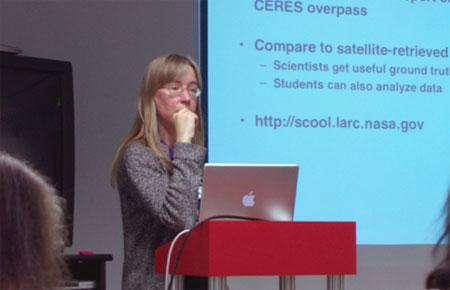
Figure 1. Dr. Lin Chambers giving a presentation to a teacher workshop in 2007.
I am a Physical Scientist at NASA Langley Research Center in Hampton, Virginia. That’s in southeastern Virginia — near Virginia Beach if you’re a beach lover; near the Jamestown–Williamsburg–Yorktown Historic Triangle if you’re a history lover; and near the edge of an ancient impact crater at the mouth of the Chesapeake Bay (Figure 2) if you’re interested in meteors, comets, crabs, sailing, or underwater aquatic vegetation. I’ve been working here for over 25 years, starting out as a Co-operative Education student while I was still in college at Rensselaer Polytechnic Institute. My studies were in aeronautical engineering, so I began my career as an aerospace technologist studying how spacecraft interact with the atmosphere as they approach a planet (re-entering Earth’s atmosphere or going to Mars). I earned a PhD in that field from North Carolina State University in 1991. After about 10 years in that field I switched my focus to the atmosphere itself.
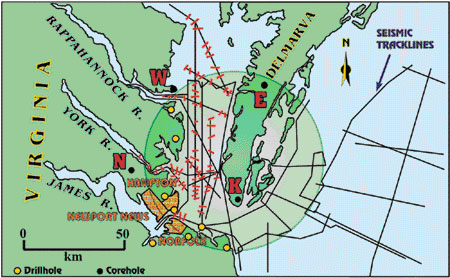
Figure 2. NASA Langley is located at about 8 o’clock in the circle showing the ancient impact crater at the mouth of the Chesapeake Bay, the largest estuary in the United States (Image credit: http://marine.usgs.gov/fact-sheets/fs49-98/)
As a physical scientist, my role is to study the science of the physical world around us. My primary interest is a wispy portion of the physical world: clouds. My work has been involved with understanding how clouds interact with sunlight and infrared radiation (heat) to help control the climate of the Earth; how clouds may be changing under the influence of climate; and what such changes in clouds might mean for Earth’s future climate. My work is part of a large team of scientists — the Clouds and Earth’s Radiant Energy System (CERES) team — that is studying this problem. One of my roles on this team has been to involve students from around the world in helping us understand this puzzle, by making and reporting local observations of clouds at the time that our satellite instruments pass over their location on Earth. This is called ground truth, and we compare these reports to what our satellite reports at that time and place to try to better understand what is going on. I am looking forward to being involved with GLOBE over the next several years to expand student involvement in understanding our home planet, Earth.
Dr. Charles Ichoku (Charles I): NASA Scientist for GLOBE Student Research Campaign on Climate
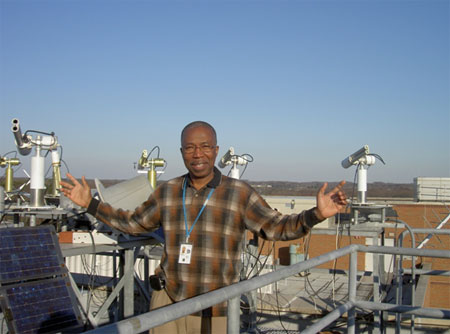
Figure 3. Dr. Charles Ichoku in the midst of sun-photometers measuring atmospheric aerosols by ground-based remote sensing at the AERONET (http://aeronet.gsfc.nasa.gov/) home base at NASA Goddard Space Flight Center, Greenbelt, Maryland, USA.
I am an Earth scientist in the Climate and Radiation Branch within the Earth Sciences Division at NASA Goddard Space Flight Center, Greenbelt, Maryland, USA. I grew up in Nigeria, where at a young age my elementary school education was interrupted in the 4th grade by a civil (Biafra) war, which raged from 1966 to 1970. During that time, my family moved from one rural village to another, trying to escape the war and to survive from day to day, and I had no time to think about school. At the end of that period, I resumed my education under difficult socio-economic circumstances. Although, I often came across the names of such famous early scientists as Newton, Faraday, and others in my science classes, and was impressed by their great discoveries, I did not see any prospects of becoming a scientist myself. However, one desire I have always had since my childhood has been to live in a clean well-planned environment that is carefully nurtured continuously to provide comfort and security for life to thrive. Therefore, I made a decision to always contribute to the best of my ability in realizing this ideal. Thankfully, I did well in mathematics and the different science subjects during my school days, had great parents who worked extremely hard to see their children succeed in life even though they themselves did not have formal education beyond the third grade, and have an awesome Father in Heaven who has been providing excellent opportunities for me.
When I was applying to the University, although I had several opportunities to study any subject I wanted, I chose to pursue a major in Surveying, which is defined in Wikipedia as: the “technique and science of accurately determining the terrestrial or three-dimensional space position of points and the distances and angles between them”. I made this choice in order to participate actively in the science of planning environmental development, determining spatial relationships between various natural and man-made features, and mapping them, so that human society could accurately keep track of our environmental resources as development advances. During the first year of my undergraduate studies at the University of Nigeria, Enugu Campus, I heard about the great achievements of NASA in sending satellites to space to monitor the earth, and even heard from some of our fellow students that our then department Chair had been involved in some NASA projects during and after his graduate studies in the USA. I thought about how cool it must be to work for NASA, but never dreamed that I could have such a glorious opportunity in a million years. In any case, something I have always been determined to do is work diligently at whatever professional activity I find myself involved in, with the goal of achieving optimum success.
Following my graduation from college, and given my great interest to join in the effort of monitoring and protecting the environment, and my desire to work with satellite data, I chose to pursue my graduate studies in the field of remote sensing, defined in Wikipedia as “the small or large-scale acquisition of information of an object or phenomenon, by the use of either recording or real-time sensing device(s) that is not in physical or intimate contact with the object (such as by way of aircraft, spacecraft, satellite, buoy, or ship)”. Shortly after I received my Masters degree, a friend brought to my attention an announcement of scholarship offered by the French government to those wishing to pursue their PhD in France. I applied and was one of those selected. I spent six years studying in France, and finally received my PhD in Earth Sciences from the Université Pierre & Marie Curie, Paris. Thereafter, I was offered the opportunity to do my postdoctoral research at the Jacob Blaustein Institute for Desert research, Sede Boker, Israel, where I spent four memorable years. Then I worked as a visiting scientist at the Max-Planck Institute for Chemistry, Mainz, Germany for a little over a year, before the unthinkable opportunity came in 1998 for me to work at NASA.
Over the years, I have been involved in developing and applying both experimental and remote sensing approaches to research various branches of the earth and atmospheric sciences. However, during the last decade, my research focus has been on the study of tiny particles suspended in the atmosphere (known as aerosols), which include dust blown by wind from Earth’s surface, smoke emitted from forest fires and other open biomass burning, as well as pollutants from industries and other human activities. I am studying the mechanisms responsible for the generation of these aerosols, particularly smoke and dust, and their sources, distribution, and impacts on air quality, human health, and climate.
When this opportunity to be a GLOBE scientist came up recently, I received it with great enthusiasm because of the prospect of helping the young generation to learn to utilize the vast amounts of observations and data from satellite and other sources for the benefit of our environment. Therefore, I am looking forward to working together with all of the talented students, motivated teachers, and great scientists and colleagues participating in GLOBE, as well as visionary members of the world community, in many exciting projects geared toward protecting our home planet from rapid degradation, and nurturing it carefully to provide much needed comfort and security for the enjoyment of life by us and future generations.
Dr. Charles. Kironji Gatebe (Charles G.): NASA Scientist for GLOBE Student Research Campaign on Climate
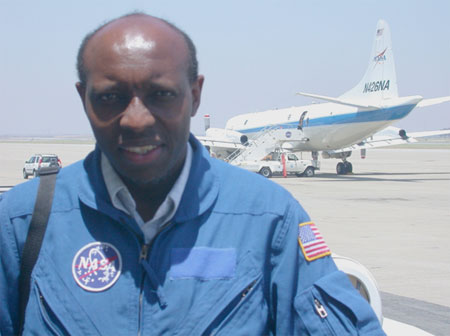
Figure 4: Dr. Gatebe at NASA Ames Research Center in California, USA on June 22, 2008 after a research flight on NASA P-3B aircraft (in the background). Picture by Rajesh Poudyal, SSAI/NASA GSFC.
I am an atmospheric scientist whose journey began in a small impoverished village in Central Kenya in mid-sixties, where my parents eked out a living from coffee plantations owned by European farmers. They earned less than $10 US dollars a month. I became attracted to reading at an early age and had to walk 10 km bare feet to and from school each day. I survived on one meal a day for nine years in pursuit of a good education. In high school I led other students in developing innovative science and technology projects, winning prizes at Kenya National School Congresses. I also led the Wildlife club in the school which was involved in wildlife conservation, where Kenya is a world leader. While attending the University of Nairobi in late 80s to early 90s, I walked the streets of Nairobi to measure pollution from motor vehicles and developed simple models for predicting pollution levels based on number of vehicles crossing any point in an hour and their average speed. My investigations on how much pollution is generated locally and how much is transported from other countries led me to take measurements on the top of Mount Kenya (>14000 feet). Having measurements for this high altitude, allowed me to separate local from region pollution and to relate episodes of peak pollution and dust concentration to air transport from the source regions in southern Africa, the Sahara desert and the Indian subcontinent. In 2000, I was fortunate enough to be recognized for these studies by receiving the Young Scientist Award from the World Meteorological Organization.
In the last 10 years, I have been working at NASA Goddard Space Flight Center as a research scientist with the Goddard Earth Sciences and Technology Center of the University of Maryland, Baltimore County. I now study interaction between light and natural surfaces such as vegetation, ocean, clouds, and pollution using airborne measurements to help improve their detection from space using satellites. I have flown on many NASA aircraft missions to validate satellite measurements in southern Africa, US East Coast over the Atlantic Ocean, US West coast over the Pacific Ocean, Alaska, Greenland and Canada. I am currently the lead investigator of NASA’s Cloud Absorption Radiometer (CAR), which is flown aboard NASA P-3B aircraft.
I received my Bachelors degree (B.S. in meteorology, mathematics, and physics) and my Masters (M.S. in meteorology) degree from the University of Nairobi, Kenya, in 1990 and 1994, respectively. I received my Ph.D. degree in atmospheric sciences from the University of the Witwatersrand, South Africa, in 1999. For a brief period in 1995, I worked as a research meteorologist at the Kenya Meteorological Department and then joined the University of Nairobi from 1995-1999, where I taught courses in air pollution using nuclear related techniques at the Institute of Nuclear Science. I came to NASA Goddard Space Flight Center in 1999 as a Resident Research Associate of the Universities Space Research Association (USRA).
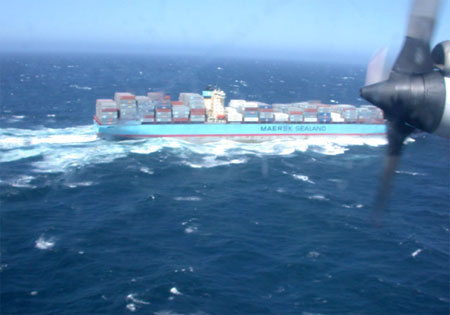
Figure 5: NASA P-3B following ship plumes over the Pacific Ocean off California coast on June 24 2008. The aircraft was equipped with instruments to measure ship pollution and radiation to help determine the types of chemicals emitted from these large marine vessels and the impact of these chemicals to air quality in California. The flight was coordinated with NASA satellites, which measures pollution from space. Picture by C.K. Gatebe.
I currently serve on the Scientific and Technical Advisory Panel to the World Bank/United Nations Environment Programme Global Environment Facility (GEF) Roster of Experts on climate change.
Dr. Robert (Bob) Cahalan: NASA Scientist for GLOBE Student Research Campaign on Climate
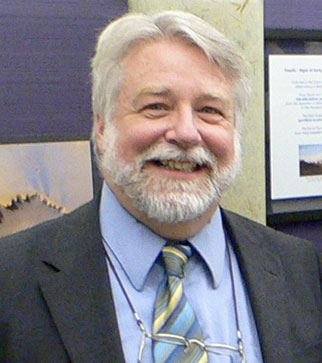
Figure 6: Dr. Bob Cahalan
I am Bob Cahalan, Head of NASA Goddard’s Climate and Radiation Branch. I hold several jobs related to climate change, and have been doing science research for more than 40 years. As you will soon learn, I love science and I love building scientific instruments and using them to discover how the universe works.
My scientific journey began in Ohio, where I grew up in two small towns, Delaware and Miamisburg. I first discovered my love of nature in the surrounding farmlands. In secondary school I built a spirometer to measure lung capacity, and won an award at a local science fair. In college two friends and I built a plasma jet that heated air to over 1000 degrees Kelvin. It was powered by several car batteries connected in series. It generated a current too large to measure with an ammeter, as that high a current would melt any ammeter. I was still able to measure the current indirectly, from the magnetic field it produced, holding a magnetometer above the wires. During my last two years in college I did electron paramagnetic resonance research, learning about crystals and building a microwave system with a 10,000 gauss magnet purchased with funds from a National Science Foundation grant. Interpreting the data from that system needed basic understanding of quantum phenomena. Wondering about weird quanta soon led me to do physics graduate study at the University of Illinois. There I published papers on subatomic particles, explaining how the proton, that make up the nucleus of atoms, is made from simpler pions, and predicting a “heavy” particle of light, like the known photons, but 80 times heavier, called the Z. My prediction was confirmed 20 years later when particle accelerators became powerful enough to produce Zs. The university awarded me a PhD in physics.
More important, during this time I married Margaret Werner, whom I’d met in college. Our first son Joel was born in Illinois. I continued my work on particle physics as a Professor at Syracuse University in New York, with side trips to research centers in Aspen, Colorado, and in Warsaw, Poland. Our second son, Gabriel, was born in Poland in 1975.
My interest in astronomy grew, as every night I used Syracuse University’s 100 year-old 8-inch refractor telescope. To pursue astronomy, I joined the faculty at Western Kentucky University, using a 16-inch telescope on the roof of the physics building, and an adjacent planetarium, and I taught astrophysics. I began to think about Earth as a planet, and spent a summer at the National Center for Atmospheric Research, NCAR, one of the premier centers for studying Earth’s atmosphere, in Boulder, Colorado. After a year teaching meteorology and fluid dynamics at the University of Missouri in Saint Louis, I returned for another year at NCAR, and began to focus on clouds, using NASA’s Landsat satellite to measure them. In 1979 I joined NASA Goddard, and have continued cloud research for 30 years.
Clouds are endlessly fascinating for their many complex and beautiful properties, and important for Earth’s climate because they control the flow of energy in the atmosphere, and the supply of energy to the oceans. At Goddard I designed a laser system with multiple views, like a bee’s eye, showing that it can see through clouds to measure their thickness, naming it THOR, for “Thickness from Offbeam Returns.” I have flown THOR over Oklahoma, Central America, and Antarctica, measuring clouds, ice, and snow. I discovered that clouds have an “effective thickness” depending on their “fractal” properties, an idea now used in global climate models.
I now study how the Sun influences Earth, and how past changes in the Sun can be measured in the Moon’s temperature, a few meters beneath the surface, in the “regolith” or dust layer. With my son, I have also published a paper on “chaotic rhythms of a dripping faucet” finding similar beauty and complexity in leaky faucets as in clouds. My wife Margaret and I founded “CHEARS” whose project “The Earth Squad” helps students observe and improve their environment, especially the air they breathe, and the water they drink.

Nice job from the scientist Peggy on her global research and i would congratulate all other scientist and wish them all a luck for success in their future research.
Very good job scientist Peggy on her global research. I would really appreciate to all other scientist for their future research . You all the scientist get success in your future life. You are doing very appreciate work for global research. Keep posting such wonderful informative blog. It is really helpful for our future.